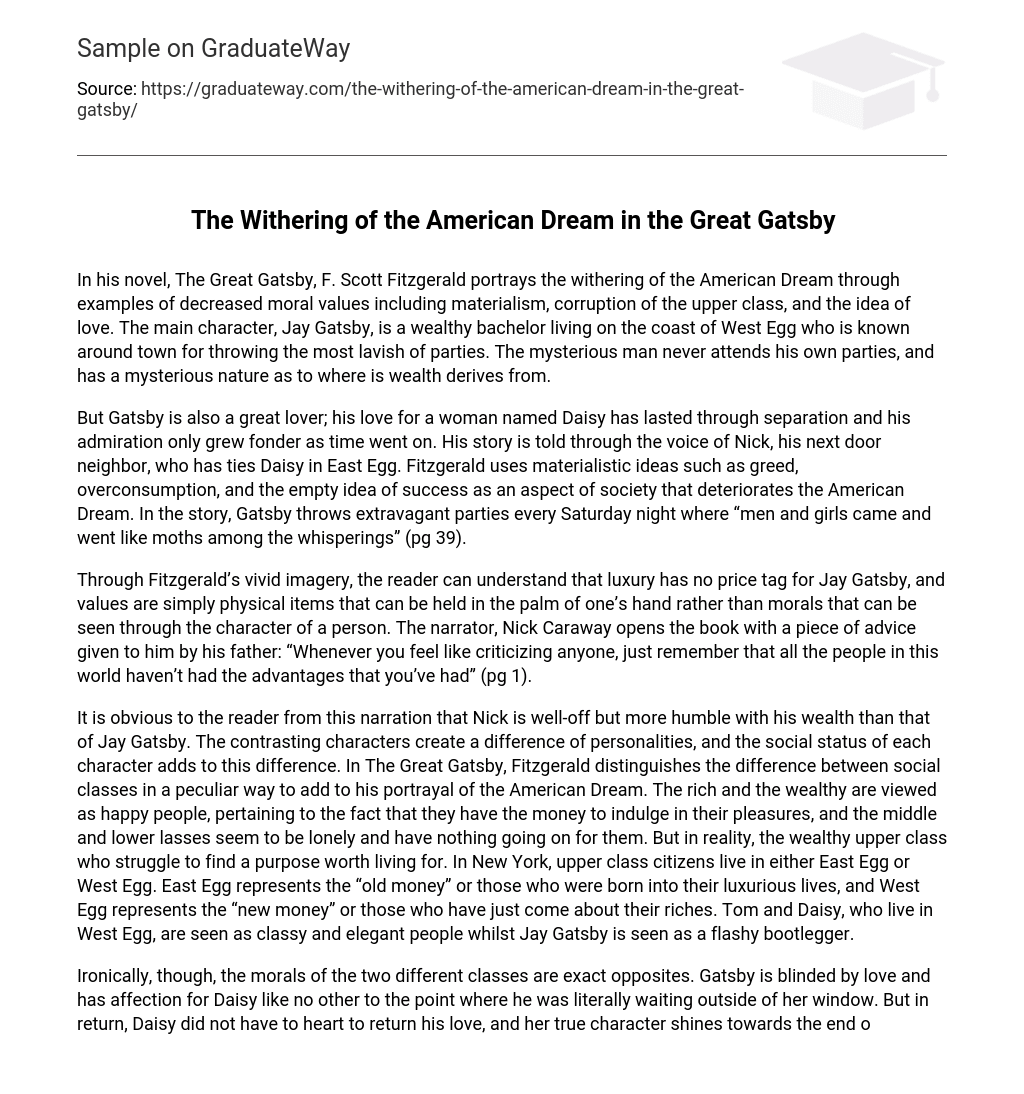In his novel, The Great Gatsby, F. Scott Fitzgerald portrays the withering of the American Dream through examples of decreased moral values including materialism, corruption of the upper class, and the idea of love. The main character, Jay Gatsby, is a wealthy bachelor living on the coast of West Egg who is known around town for throwing the most lavish of parties. The mysterious man never attends his own parties, and has a mysterious nature as to where is wealth derives from.
But Gatsby is also a great lover; his love for a woman named Daisy has lasted through separation and his admiration only grew fonder as time went on. His story is told through the voice of Nick, his next door neighbor, who has ties Daisy in East Egg. Fitzgerald uses materialistic ideas such as greed, overconsumption, and the empty idea of success as an aspect of society that deteriorates the American Dream. In the story, Gatsby throws extravagant parties every Saturday night where “men and girls came and went like moths among the whisperings” (pg 39).
Through Fitzgerald’s vivid imagery, the reader can understand that luxury has no price tag for Jay Gatsby, and values are simply physical items that can be held in the palm of one’s hand rather than morals that can be seen through the character of a person. The narrator, Nick Caraway opens the book with a piece of advice given to him by his father: “Whenever you feel like criticizing anyone, just remember that all the people in this world haven’t had the advantages that you’ve had” (pg 1).
It is obvious to the reader from this narration that Nick is well-off but more humble with his wealth than that of Jay Gatsby. The contrasting characters create a difference of personalities, and the social status of each character adds to this difference. In The Great Gatsby, Fitzgerald distinguishes the difference between social classes in a peculiar way to add to his portrayal of the American Dream. The rich and the wealthy are viewed as happy people, pertaining to the fact that they have the money to indulge in their pleasures, and the middle and lower lasses seem to be lonely and have nothing going on for them. But in reality, the wealthy upper class who struggle to find a purpose worth living for. In New York, upper class citizens live in either East Egg or West Egg. East Egg represents the “old money” or those who were born into their luxurious lives, and West Egg represents the “new money” or those who have just come about their riches. Tom and Daisy, who live in West Egg, are seen as classy and elegant people whilst Jay Gatsby is seen as a flashy bootlegger.
Ironically, though, the morals of the two different classes are exact opposites. Gatsby is blinded by love and has affection for Daisy like no other to the point where he was literally waiting outside of her window. But in return, Daisy did not have to heart to return his love, and her true character shines towards the end of the novel with the fact that she could not even show up to Gatsby’s funeral. The idea of love was part of the American Dream that Fitzgerald portrayed through his writing. F.
Scott Fitzgerald’s novel, The Great Gatsby takes place in the 1920’s where the American Dream was the laced with cynicism, greed and the pursuit of pleasure. Jay Gatsby seeks to rekindle an old love with a woman named Daisy, and through secret rendezvous, Gatsby is able to achieve his goals. But just as their relationship seemed to be turning serious, Gatsby is knocked on his back with the harsh reality of his one-sided love. Fitzgerald describes the corrupt idea of the American Dream through the life Gatsby had imagined for years.
Gatsby had held Daisy on the highest of all pedestals and imagined her to be a person of virtue that she did not necessarily deserve. In his eyes, this was his dream, but as “[Gatsby] realizes that his presumptuous little flirtation is over” (pg 135), his dream is crushed by the object of his affection herself. In comparison with the theme, the era of the 1920’s had a promising future with an excess of money and pleasure, but this turned into a quest for greed instead of happiness, which furthermore describes the decay in the American Dream.





